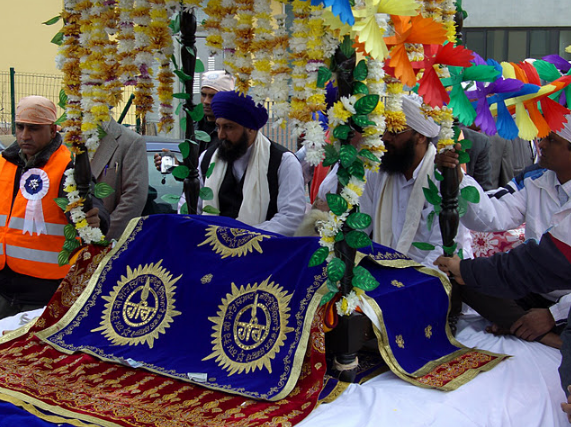
| Version | Summary | Created by | Modification | Content Size | Created at | Operation |
|---|---|---|---|---|---|---|
| 1 | Dean Liu | -- | 1605 | 2022-11-16 01:35:18 |
Video Upload Options
The Ravidassia religion, also called Ravidasia Dharm, is an Indian religion, founded in the 14th-century. It is based on the teachings of the 14th century Indian guru Ravidass, revered as a Satguru, particularly by ravidasia community Historically, Ravidassia represented a range of beliefs in the Indian subcontinent, with some devotees of Ravidass counting themselves as Ravidassia, but first formed in the early 20th-century in colonial British India. The Ravidassia community began to take on more cohesion following 1947, and the establishment of successful Ravidassia communities in the diaspora. Ravidassias believe that Ravidas is their Guru (saint) whereas the Sikhs have traditionally considered him as one of many bhagats (holy person). Further, Ravidassias accept living sants of Ravidass Deras as Guru whereas the Sikhs do not, states Ronki Ram. A new Ravidassia religion was launched following an assassination attack on their visiting living Guru Sant Niranjan Dass and his deputy Ramanand Dass in 2009 in Vienna by Sikh militants. Ramanand Dass died from the attack, Niranjan Dass survived his injuries, while over a dozen attendees at the temple were also injured. This triggered a decisive break of the Ravidassia group from the orthodox Sikh structure. Prior to their break from Sikhism, the Dera Bhallan revered and recited the Guru Granth Sahib of Sikhism in Dera Bhallan. However, following their split from mainstream Sikhism, the Dera Bhallan compiled their own holy book based exclusively on Ravidas's teachings, the Amritbani Guru Ravidass Ji, and these Dera Bhallan Ravidassia temples now use this book in place of the Guru Granth Sahib.
1. Basis
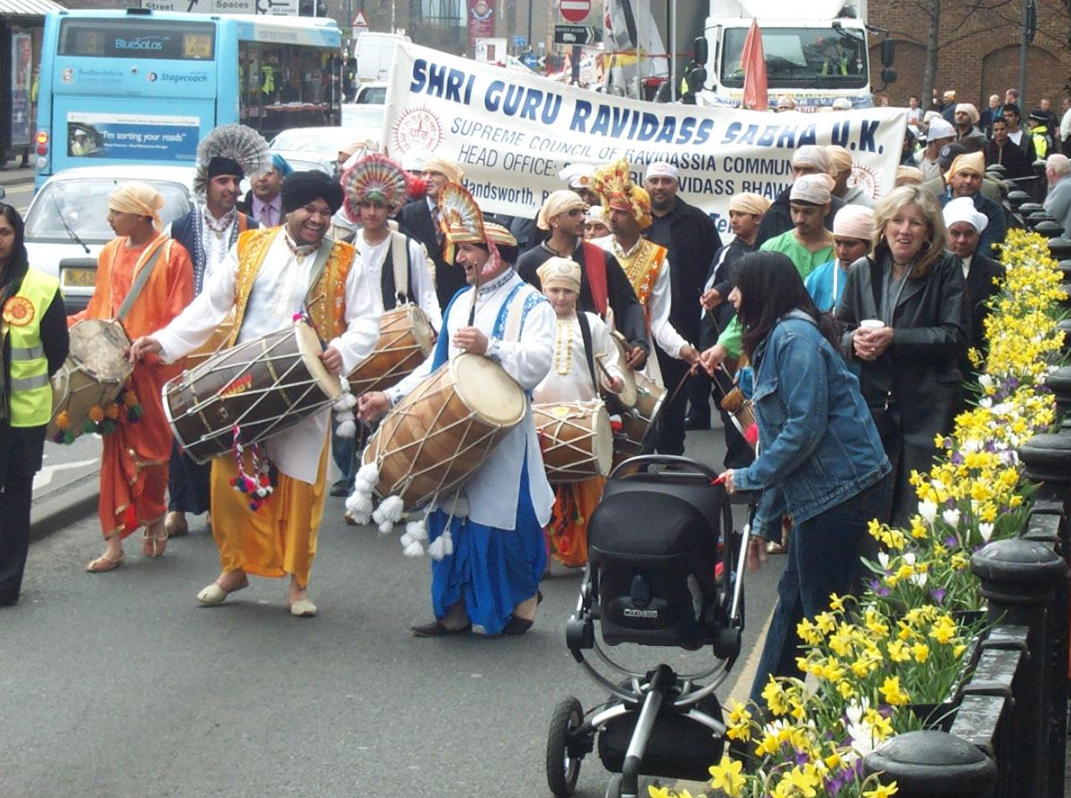
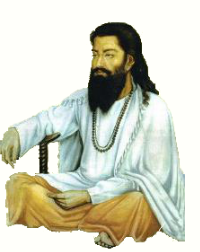
Ravidas was born on 15 January 1377 CE (Indian calendar Sunday Sukhal Falgin Parvithta 1433) to the chamar community[1] .[2] His birthplace was a locality known as Seer Govardhan in the city of Varanasi, Uttar Pradesh state, India. The birthplace is now marked by the Shri Guru Ravidass Janam Asthan (Begampura), and is a major place of pilgrimage for the followers of Guru Ravidas today. Ravidassia believe that Ravidas died in Benares at the age of 151.[3][4][5]
2. Beliefs
Teachings of Ravidas represent an offshoot of the bhakti movement of the fifteenth century, a religious renaissance in India. Ravidas taught the following principles:
- The oneness, omnipresence and omnipotence of God.
- The human soul is a particle of God.
- The rejection of the notion that God cannot be met by lower castes.
- To realize God, which is the goal of human life, man should concentrate on God during all rituals of life.
- The only way of meeting with God (moksha) is to free the mind from duality.
3. Membership
The Shri Guru Ravidas Mission states that the conditions on being a member of the community are:
- That one who preaches Guru Ravidas's philosophy is a Ravidassia.
- It is not a condition that one should have been born in the Ravidassia community to become or to be initiated as one.
- To celebrate Shri Guru Ravidass Jayanti according to the Punjabi calendar, Sunday, Sukhal Falgin Parvithta.
4. Objectives
Dera Sach Khand Ballan of Jallandhar, Punjab on 30 January 2010 at the 633rd birth anniversary of Ravidas announced the objectives of Ravidassia religion as, "to propagate the Bani and teachings of Satguru Ravidass. Besides, the teachings and thought of Maharishi Bhagwan Balmiki, Satguru Namdev, Satguru Kabir, Satguru Trilochan, Satguru Sain and Satguru Sadna would also be propagated".
5. Places of Worship
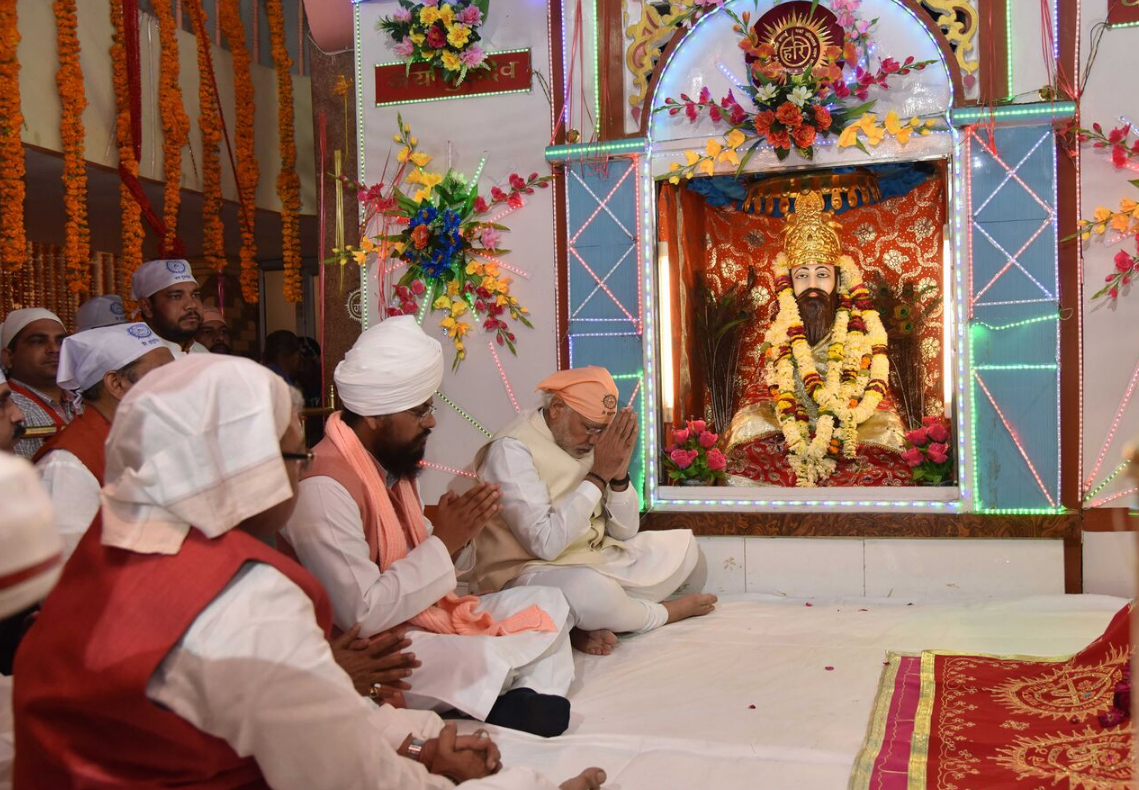
According to National Vice President Akhil Bhartiya Ravidassia Dharm Sangthan Sant Mandeep Dass the Ravidassia place of worship is called a Dera, Sabha, or Mandir (temple).[6] It is considered respectful towards Guru Ravidas if one covers his head and takes off his or her shoes while entering the place of worship. It is believed that everyone must follow it as a respect to Guru Ravidas.
Outside the Sabha there is always a flag upon which is written the Nishaan, and above it the "Harr" symbol which symbolising enlightenment from Guru Ravidas's teachings.
Langar takes place inside the sabha continuously as a practice, all are free to partake of it.
In some Ravidassia sabhas the Guru Granth Sahib is still installed as the focal point in the main worship room. The Guru Granth Sahib is respected at all times. However most Ravidassia Sabhas have replaced it with the new holy book, the Guru Ravidass Amrit Bani.
Aarti and kirtan of all saints and gurus takes place daily at the closing of the day's formal services, this consists of the famous Arti written by Guru Ravidas in which he tells God is one and equality is among all in the eyes of God.
Some saints which Ravidassias refer to while at the end of every prayer is Satguru Kabir, Satguru Sain, Satguru Sadhna, Satguru Trilochan, Meera Bai, Baba Farid and Bhagwan Valmik.
6. Scriptures
The Ravidassia temples "Sabha" contain the holy book Amritbani Guru Ravidass Ji which contains all the hymns by Guru Ravidas. This book contains the following hymns: Raga – Siri (1), Gauri (5), Asa (6), Gujari (1), Sorath (7), Dhanasari (3), Jaitsari (1), Suhi (3), Bilaval (2), Gaund (2), Ramkali (1), Maru (2), Kedara (1), Bhairau (1), Basant (1), and Malhar (3). The book contains 140 shabads, 40 pade, and 231 salok. There are 177 pages in all of the book.
A version of the holy book Amrit Bani containing 240 hymns of Guru Ravidas was installed at the Guru Ravidas temple in Jalandhar, Punjab, on 1 February 2012 on the occasion of birth anniversary of Guru Ravidass. The Dera Sach Khand Ballan religious community had announced the formation of the new Ravidassia religion and separation from Sikhism at Varanasi. The split from Sikhism was triggered after the killing of its deputy head Ramanand Dass in May 2009 at a temple in Vienna by some Sikh radicals.
President of newly formed Begumpura Lok Party and a supporter of the new religion, Satish Bharti, said that the copies of the new Bani were put on display during the religious processions in order to assert that the community members are firm believers of the new religion.[7][8]
7. Leaders
Ravidassias are aligned with a sant who mentors them on their spiritual path, providing personalised mantras and advice. The head of the Ravidassia Dharam, known as the sadhus are present mainly in Punjab and the Dera Sach Khand Ballan consists of sadhus, also known as Sant Samaj who in turn lead and are heads of all Ravidassias deras around the world. The leader of the Ravidassia religion, known as the Gaddi Nashin is Sant Niranjan Dass and former leaders include Sant Hari Dass, Sant Sarwan Dass, Sant Garib Dass and Sant Baba Pippal Dass.[9]
8. Customs
The Ravidassia employ the greeting "ਜੈ ਗੁਰੂਦੇਵ" (Jai Gurdev, जय गुरुदेव), meaning “hail the teacher of god”, the motto of the religion.[10]
9. Symbols
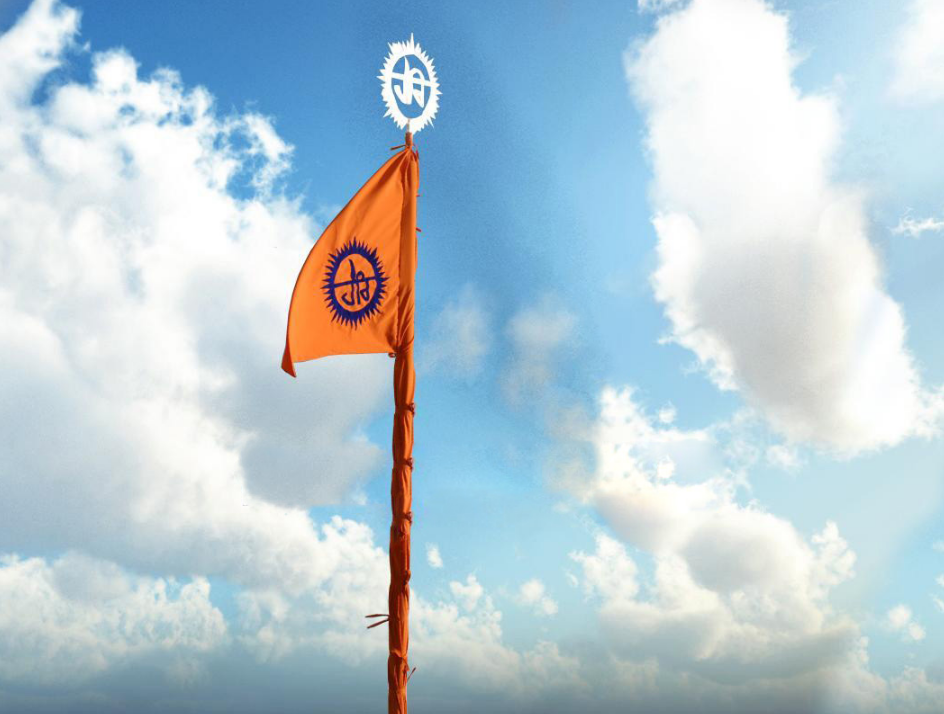
The Ravidassia religious symbol is known as the Harr Nishaan ("sign of God"). The Gurmukhi transliteration of the name Harr is the main symbol of the Ravidassia religion.[11] It is also called as Koumi Nishan.[12]
The religion is also represented by a flag, with the insignia "Har" which, states Ronki Ram, includes:[12]
- A bigger circle with 40 rays of sunlight signifying forty hymns of Guru Ravidas;
- Inside the big circle is a small circle, inside which is written "Har" in Gurmukhi language (ਹਰਿ) with a flame on top of it;
- The flame represents the Naam (word) that would illuminate the entire world, and reaches the outer circle;
- Between the two circles is written a couplet composed by Ravidas: ਨਾਮ ਤੇਰੇ ਕਿ ਜੋਤੀ ਲਗਾਈ, ਭੇਈਓ ਓ ਭਵਣ ਸਗਲਈ (Naam tere kee jot lagayi, Bhaio Ujiaaro Bhawan saglaare, "Your Name is the flame I light; it has illuminated the entire world")
The insignia Har, states Ram, represents the "very being of Ravidass and his teachings".[12] It is chosen after the name of their Guru, as ravi means "illumination" and dass "servant of god".
10. Relationship with Sikhism
Dera Bhallan Ravidasis claim that their religion was created after they were excluded from Sikh gurdwaras in Punjab.[13] There are many similarities with mainstream Sikhism and indeed temple worship is similar. The primary difference is the reverence of Ravidas as their main Guru, and the use of Ravidas teachings as the primary scripture and their spiritual Satguru in contrast to Guru Granth Sahib being the scripture and Satguru of the Sikhs. The Ravidassias also accept images and idols of Ravidas in their temples.
11. Festival
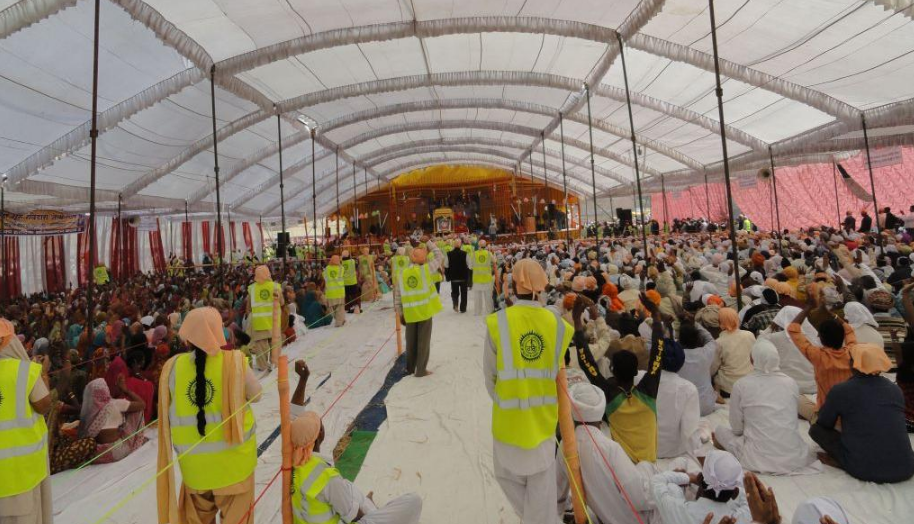
The birthday of Ravidas is celebrated every year at the Seer Gowardhanpur village temple in Varanasi the state of Uttar Pradesh in January or February and the government of India has declared it a gazetted holiday.[14]
Every year more than 1 million devotees from India and abroad visit the Seer Goverdhanpur temple. In India, devotees pour in from Punjab, Haryana, Gujarat, MP, Bihar, UP and Uttarakhand while foreign devotees from the US, Canada and UK throng the village.
On the day there is a Path of Amritbani Guru Ravidas read, the Harr(i) nishaan sahib is changed ceremonially, and there is a special Ravidassia Arti and a Nagar Kirtan procession bearing Shri Guru Ravidas' portrait are taken out to the accompaniment of music through the streets of the temple locality.
Begampura Special pilgrim trains been run to and from Varanasi for the last 12 years on the occasion of Parkash Ustav of Guru Ravi Dass. A special train is run from Jalandhar to Varanasi and back every year on Guru Ravidass Jyanti Purb for the convenience of the pilgrims since 2000.
References
- Lochtefeld, James G. (2002) (in en). The Illustrated Encyclopedia of Hinduism: N-Z. The Rosen Publishing Group. p. 512. ISBN 9780823931804. https://archive.org/details/illustratedencyc0000loch.
- "Ravidas | Indian mystic and poet" (in en). https://www.britannica.com/biography/Ravidas.
- "Amid tight security, Dera Ballan head, followers head for Varanasi". Indian Express. 2011-02-16. http://www.indianexpress.com/news/amid-tight-security-dera-ballan-head-follo/750310/. Retrieved 2012-07-17.
- "Ravidass followers declare separate religion, release separate granth". SikhNet. 2010-02-01. http://www.sikhnet.com/news/ravidass-followers-declare-separate-religion-release-separate-granth. Retrieved 2012-07-17.
- "Ravidassia community part of Sikh faith: SGPC". Zeenews.india.com. 2010-02-04. http://zeenews.india.com/news/states/ravidassia-community-part-of-sikh-faith-sgpc_601649.html. Retrieved 2012-07-17.
- http://www.gururavidas.org.uk/ point 15: # To address our place of worship as Ravidassia Temple’ all the time and for all the purposes.
- "Punjab News - No ‘Guru Granth Sahib’ but ‘Amrit Bani’ adorned at Ravidas Sobha Yatra". Jagopunjabjagoindia.com. 2010-01-30. http://jagopunjabjagoindia.com/no-guru-granth-sahib-but-amrit-bani-adorned-at-ravidas-sobha-yatra-3292. Retrieved 2012-07-17.
- "Ravidassias assert identity, display new Granth in shobha yatras". Indian Express. 2012-02-07. http://www.indianexpress.com/news/ravidassias-assert-identity-display-new-granth-in-shobha-yatras/908944/0. Retrieved 2012-07-17.
- Prof Ronki Ram (2012-07-13). "Dera Sachkhand Ballan: Repository of Dalit consciousness". Deccanherald.com. http://www.deccanherald.com/content/5450/dera-sachkhand-ballan-repositorydalit.html. Retrieved 2012-07-17.
- Amrita Chaudhry (2010-02-03). "Religion or a prayer for identity?". Indian Express. Ludhiana. http://www.indianexpress.com/news/religion-or-a-prayer-for-identity/574754. Retrieved 2013-12-05.
- "Punjab sect declares new religion". The Times Of India. 2010-02-01. http://articles.timesofindia.indiatimes.com/2010-02-01/india/28118439_1_dera-head-dera-sachkhand-ballan-sant-ramanand.
- Ronki Ram (2009). "Ravidass, Dera Sachkhand Ballan and the Question of Dalit Identity in Punjab". Journal of Punjab Studies (Panjab University, Chandigarh) 16 (1): 20. http://www.global.ucsb.edu/punjab/journal/v16_1/articles/RonkiRam16_1.pdf.
- Parsons, Gerald (1994). The Growth of Religious Diversity: Britain from 1945. Routledge. p. 227. ISBN 0415083265.
- "City Briefs : PGI OPDs to be closed on Feb 7". Indian Express. 2012-02-06. http://www.indianexpress.com/news/city-briefs-pgi-opds-to-be-closed-on-feb-7/908346/. Retrieved 2012-07-17.


